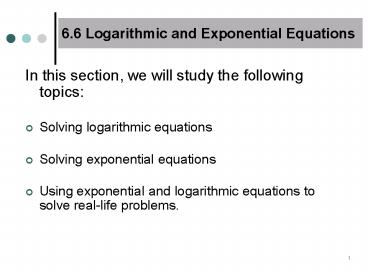6.6 Logarithmic and Exponential Equations - PowerPoint PPT Presentation
1 / 25
Title:
6.6 Logarithmic and Exponential Equations
Description:
6.6 Logarithmic and Exponential Equations In this section, we will study the following topics: Solving logarithmic equations Solving exponential equations – PowerPoint PPT presentation
Number of Views:181
Avg rating:3.0/5.0
Title: 6.6 Logarithmic and Exponential Equations
1
6.6 Logarithmic and Exponential Equations
- In this section, we will study the following
topics - Solving logarithmic equations
- Solving exponential equations
- Using exponential and logarithmic equations to
solve real-life problems.
2
Strategies for Solving Logarithmic Equations
- There are two basic strategies for solving
logarithmic equations - Converting the log equation into an exponential
equation by using the definition of a
logarithm - Using the One-to-One Property
3
Solving Logarithmic Equations
- I. Converting to Exponential Form
- ISOLATE the logarithmic expression on one side of
the equation. - CONVERT TO EXPONENTIAL FORM
- SOLVE for x. Give approximate answers to 3
decimal places, unless otherwise indicated.
4
Example Converting to Exponential Form
Solve
5
Solving Logarithmic Equations
- II. Using the One-to-One Properties
- Can be used if the equation can be written so
that both sides are expressed as SINGLE
LOGARITHMS with the SAME BASE. - Use the properties of logarithms to CONDENSE the
log expressions on either side of the equation
into SINGLE LOG expressions. - Apply the ONE-TO-ONE PROPERTY.
- SOLVE for x. Give approximate answers to 3
decimal places, unless otherwise indicated.
6
Example One-to-One Property for Logs
Solve log3x 2log35 log3(x 8)
7
PRACTICE!!
Solve each of the following LOGARITHMIC
equations.
8
PRACTICE!!
9
PRACTICE!!
10
PRACTICE!!
11
Strategies for Solving Exponential Equations
- There are two basic strategies for solving
exponential equations - Using the One-to-One Property
- Taking the natural or common log of each side.
12
Solving Exponential Equations
- Using the One-to-One property
- Can be used if the equation can be written so
that both sides are expressed as powers of the
SAME BASE - Use the properties of exponents to CONDENSE the
exponential expressions on either side of the
equation into SINGLE exponential expressions. - Apply the ONE-TO-ONE PROPERTY.
- SOLVE for x. Give approximate answers to 3
decimal places, unless otherwise indicated.
13
Example One-to-One Property
Solve
14
Example One-to-One Property
Solve
15
Solving Exponential Equations
- Taking the Natural or Common Log of Each Side
- If there is one exponential term, ISOLATE the
exponential term on one side of the equation. - TAKE THE NATURAL OR COMMON LOG OF EACH SIDE of
the equation. - Use the property to
get the variable out of the exponent. - SOLVE for x. Give approximate answers to 3
decimal places, unless otherwise indicated.
16
Example Taking the Log of Each Side
Solve 3(54x1) -7 10
17
Example Taking the Log of Each Side
Solve.
18
PRACTICE!!
Solve each of the following EXPONENTIAL
equations.
19
PRACTICE!!
20
PRACTICE!!
21
Solving Exponential and Logarithmic Equations
Graphically
- Remember, you can verify the solution of any one
of these equations by finding the graphical
solution using your TI-83/84 calculator. - Enter the left hand side of the original equation
in y1 - Enter the right side in y2
- Find the point at which the graphs intersect.
Below is the graphical solution of the equation
2ln(x - 5) 6
The x-coordinate of the intersection point is
approximately 25.086. This is the (approx)
solution of the equation.
22
Exponential Growth Example
The population of Asymptopia was 6500 in 1970 and
has been tripling every 12 years since then. In
what year will the population reach 75,000?
Let t represent the number of years since 1970
P(t) represents the population after t years.
23
A Compound Interest Example
How long will it take 25,000 to grow to 500,000
at 9 annual interest compounded continuously?
Use the compound interest formula
Where P Principal (original amount invested or
borrowed) r annual interest rate t
number of years money is invested A the
amount of the investment after t years
24
A Compound Interest Example (cont.)
Substitute in the given values and solve for t.
25
- End of Section 6.6































